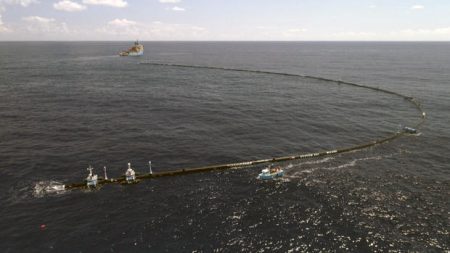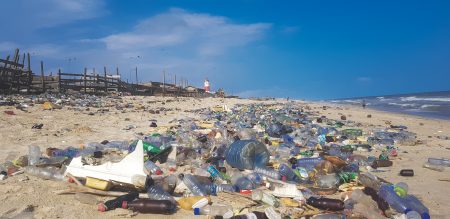December 19, 2018 – When the CBS news program, “60 Minutes,” last weekend featured the state of the world’s plastic waste and what we were doing about it, it was bad enough seeing images of rivers and harbours covered from shore-to-shore. In the segment, it featured the young inventor, Boyan Slat, whose floating boom made of PVC materials is being towed to the Great Pacific Garbage Patch to tackle an estimated 1.8 trillion pieces of plastic waste floating there. I give Slat credit for recognizing the challenge we face in dealing with plastic waste and that the ultimate dump for the stuff is our world’s oceans. But I am a skeptic about the efficacy of his solution when the problem originates on land at the point of manufacturing and use.

The human condition today includes addiction to plastic. We cannot live without it and the awful statistic revealed this week states that 90.5% of the plastic we create every year never is recycled. It makes me wonder why my wife and I bother to recycle the plastic clamshells, take-out food containers, soda bottles, detergent containers, cleaning supplies, and numerous miscellaneous items purchased weekly from our local grocer. I felt that I was doing my part when I stopped buying one-time-use plastic water bottles a few years ago. That when I bundled together all of the plastic we consumed each week and took it down to our building’s recycling room that I was contributing to a sustainable future for our planet. But lo and behold over 90% of the plastic I religiously have been collecting never gets recycled. At best it gets stored in warehouses seeking buyers of the stuff. Or it finally gets hauled to landfill sites where it is buried and becomes an artifact of our present age, the Anthropocene.
The 90.5% number stated above comes from a July 19, 2017, study published in Science Advances. The authors are:
- Roland Geyer, Associate Professor, Bren School of Environmental Science and Management, UC-Santa Barbara
- Jenna Jambeck, Assistant Professor of Environmental Engineering, University of Georgia
- Kara Lavender Law, Research Profesor of Oceanography at the Sea Education Association, Woods Hole, Massachusetts
More about their study later. But first a memory to share. In the movie “The Graduate,” released in 1967, the year I graduated from high school, one scene about plastic comes to mind. It happens early in the film when Benjamin Braddock, played by Dustin Hoffman, is welcomed home by his parents throwing a graduation party thrown for him but for their adult friends. One of those friends takes the young Ben aside and says “There’s a great future in plastics. Think about it.”
You see plastic has been around since before World War Two, and its widespread use really began in the early 1950s. Used largely for packaging, plastic quickly replaced glass, wood, and metal. As our Western societies adopted the notion of single-use throwaway containers, the stuff went from 1% of municipal solid waste in 1960 to more than 10% by 2005 in countries like Canada and the United States.
Plastics come largely from fossil fuels adding another reason for our modern dependency on these extracted resources. It comes as polyurethane, polyethylene, polypropylene, polyvinyl chloride (the PVC used today in water pipes to replace steel, concrete, and lead), polyester, acrylic fibers, and many other polymers. Other interesting facts:
- The growth in the manufacturing of plastic resins has been geometric from 2 Megatons in 1950 to 380 Megatons in 2015.
- The growth in plastic fibers and resins in total reached 7,800 Megatons in 2015 of which 3,900 Megatons was produced from 2002 to 2015.
Biodegradable plastics, on the other hand, during the same period of the study only grew to 4 Megatons. Biodegradables come from fossil fuels or from natural materials like corn starch. Their common characteristic is they can decompose when exposed to bacteria which consumes the material, or sunlight which breaks it down to single molecules.
And then there is a category called eco-plastics, plastics made from recycled plastic. In their study, Geyer, Jambeck, and Law, don’t reference eco-plastics at all.
But what their study concludes is that all the plastic waste ever generated by the year 2015 amounted to 5,800 Megatons of which the vast majority was not being recycled. The fate of the non-recycled plastics was usually landfill. Destroying the plastic through incineration was the second route. And then there was pyrolysis, which turned the plastic waste into fuel. But much of the plastic waste never underwent any of these three post-production processes ending up in drainage ditches, sewers, streams, rivers, and ultimately the ocean.
Of the plastic produced today for our commercial use, approximately 30% is turned into packaging materials. And one-time-use throwaway materials that end up discarded in landfill or incinerated represent 60%. For the remaining 10% of what we can call mismanaged plastic, there appears to be no data.
In a 2015 talk the authors gave prior to the release of their study at an AAAS meeting in San Jose, California, they described plastic consumption as doubling every 10 years suggesting our addiction will continue to grow without an end in sight.
Law described one of the findings: “the amount of plastic entering the ocean from….waste generated on land is 20 to 2000 times larger than estimates of the amount of plastic floating at the sea surface globally…..the discrepancy between what we know is entering the ocean and what we can account for from ocean measurements is huge.” That’s why I don’t see how Slat’s floating boom has much of a chance of doing what is intended, to rid the world’s oceans of plastic pollution. Not all plastic floats, and much of it is suspended in the water column well below where Slat’s device is deployed. And the rest of it is lying on the bottom of the sea.
This missing plastic is getting into marine mammals like whales, seals, sea lions, seabirds, crustaceans, barnacles, mussels, clams, and fish. The “60 Minutes” segment visited Midway Island an albatross nesting ground. Many of the nestlings that were dying prematurely had stomach contents containing more than 70% plastic causing the birds to succumb to severe malnutrition.
The solution appears obvious. If we cannot cut down on our plastic addiction, we can at least cut back on plastic waste by capturing the materials and managing them properly. That means raising the awareness of the public that goes beyond current recycling efforts. It also means developing technologies to capture waste plastic before it reaches the oceans of the world. And it means technologies for better reprocessing. Of course, we could attempt to wean ourselves off plastic by finding substitute materials, a smarter strategy but much harder for our modern industrial world to contemplate.









